|
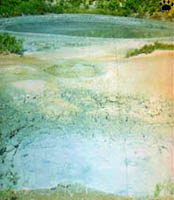
Explosive crater and crater lake,
Gergun Mud Volcano, Azerbaijan.
Mud Volcanoes of the Caspian Desert.
Mud volcanoes exist on all continents and in all oceans, but their largest concentration is in and around the Caspian Sea. More than half of the World's mud volcanoes is in or off Eastern Azerbaijan. Here they are studied because of their association with oil and gas fields. |
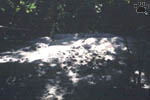
Mud volcano, Pulau Tiga, Sabah. |
In other regions, they can also be
associated with "normal" volcanism, such as in Yellowstone, or with obscure tectonic movements, such as in the rainforests of Pulau Tiga and Tabin on Malaysian Borneo. |
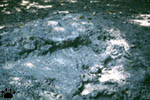
Mud volcano, Pulau Tiga, Sabah. |
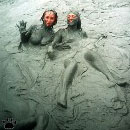
Mud volcano-based spa, Taman. |
In addition to being markers of oil and gas deposits,
mud volcanoes are used as sources of hot water, natural gas, and
clay. On Azov Sea coasts, their mud is believed to have medical
qualities, and is used in local spas. Few geologists are interested
in them, so there is no special terminology to describe their shapes
and eruptions. |
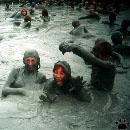
Mud volcano-based spa, Taman. |
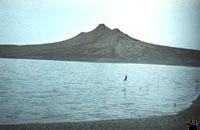
Stratovolcano and lake-filled sink caldera,
Gekpatlavuk Volcanoes, Turkmenistan. |
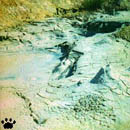
Rift fissure with cones and lakes,
Shirvan Plains, Azerbaijan. | 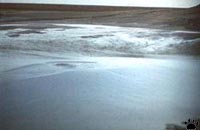
Shield volcano and lava field,
Gekpatlavuk Volcanoes, Turkmenistan. |

Oil refinery at the base of
Kagatdag (1000m/3300'),
the world's largest mud
volcano, Azerbaijan. |
I'll use the terminology borrowed from "normal"
volcanology, but, of course, if I write "lava flow" or "lava lake",
you have to keep in mind that I mean lava-like mud. What is amazing
about mud volcanoes is that they come in shapes as diverse as "normal"
volcanoes. Almost all types of cones, craters, and other geological
features known to volcanology, can also be found (usually on smaller
scale) in mud volcanoes. |
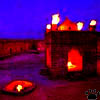
Zoroastrian temple
with eternal gas flames,
Apsheron Peninsula,
Azerbaijan. |

Lava plateau and small crater,
Shirvan Plains, Azerbaijan. |

Summit crater with hot lava lake,
Apsheron Peninsula, Azerbaijan. |
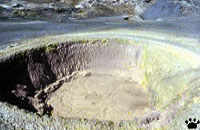
Dry explosion caldera,
Apsheron Peninsula, Azerbaijan. |
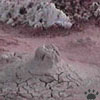
Hornito and old dykes,
Apsheron, Azerbaijan. |
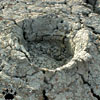
Extinct crater,
Apsheron, Azerbaijan. |
Despite their spectacular diversity,
mud volcanoes of Azerbaijan and Turkmenistan have yet to be discovered
as a tourist attraction. |

Collapse caldera,
Apsheron, Azerbaijan. |
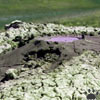
Summit crater with
tiny lava lake, Crimea. |

Maar ("crater without a cone") and sink rift,
Gekpatlavuk Volcanoes, Turkmenistan. |
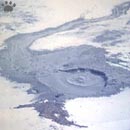
Active caldera and lava flow,
Gobystan Highlands, Azerbaijan. |
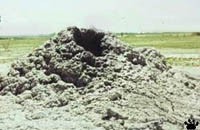
Spattering cone with collapsed slope,
Shirvan Plains, Azerbaijan. |

Lava fountain (actually, pure oil),
Apsheron, Azerbaijan. |
Eruptions of mud volcanoes are seldom
violent, although they can cause landslides and river dammings.
Only few mud volcanoes, such as the ones on mud-volcanic islands
off Baku City, are known for hot gas explosions, and have caused
human fatalities at least three times since 1900. |
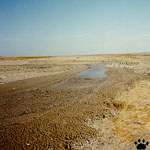
Lava flow from a rootless shield,
Shirvan, Azerbaijan. |

Boiling lava lake,
Gobystan Highlands, Azerbaijan. |
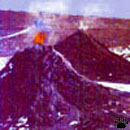
Explosion of hot lava and steam,
near Sumgait, Azerbaijan. |
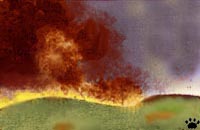
Explosion of hot gas,
Bulla Island, Azerbaijan. |
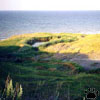
Peninsula created by
1980 eruption, Crimea. |
In 2001, an eruption of a large underwater
mud volcano off Baku created a new island, which is now almost one
sq. km in size. Another volcano not far from Baku have erupted at
least ten times since 1980, with flames reaching 300 m (1000') height. |

Small underwater
volcano, off Dagestan. |
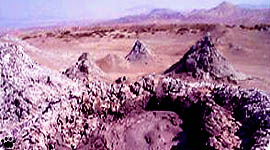
Mud-volcanic landscape, Apsheron Peninsula, Azerbaijan. |
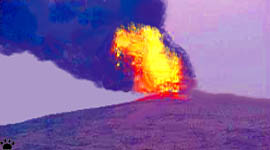
Eruption of burning oil and gas, Apsheron Peninsula, Azerbaijan. |
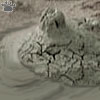
Lava flow from a lava obelisk,
Nahir mud volcano, Kazakhstan.
Home
|

